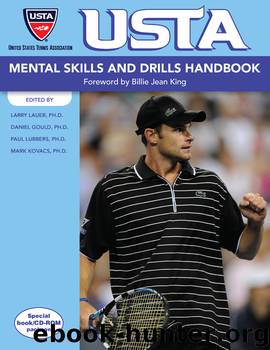USTA Mental Skills and Drills Handbook by Daniel Gould Larry Lauer

Author:Daniel Gould Larry Lauer [Larry Lauer, Daniel Gould, Paul Lubbers & Mark Kovacs]
Language: eng
Format: epub
Publisher: Coaches Choice
Note : All the forms
and worksheets
referred to in the drill descriptions in this
chapter are included on the companion
CD-ROM.
Player Activities
Off-Court Drill 13-1: Projecting a Winning Image
Roetert & Weiss (1997)
Objective : To teach players to learn to use specific behaviors to control thoughts and emotions during match play
Total Time of Activity : 15 to 30 minutes
Mental Skills Addressed : Positive body language, positive approach to mistakes, arousal control, concentration, positive self-talk, self-confidence
Equipment : One copy of Form 13-1 (Judges’ Score Sheet), three markers
Area Needed : On-court or off-court
Personnel Required : 1 to 3 judges, 3 to 5 players
Set-Up (3 minutes) :
• You will need 1 to 3 players to serve as judges and at least 3 to 5 players. (If working only with one player, have family members and other players join in the exercise. The key is to make it light but informative.)
• Assign 1 to 3 people to judge the players in each scenario (they will rate the players on a scale of 1 to 10).
• Explain to the judge(s) that the players will be judged on how they perform during two scenarios (1 = poor, 5 = okay, and 10 = perfect), and to write their score on the judging scorecard (Form 13-1).
Procedure (12 to 17 minutes):
• Step 1: Read scenarios 1 and 2 (listed in Steps 3 and 5) to each of the players, and have them perform one at a time.
• Step 2: The first time the players act out a scenario, have them react the way they would normally react. Then, have the players act out a more positive way for them to react to the mistake.
• Step 3: Scenario 1: React to a bad line call . The player’s opponent calls a solid overhead on set point out, which the player believed fell well inside the line. This instance is the third time in the last two games that the player believes he has received a bad call. The player must effectively respond to the bad call and prepare to play the next point.
• Step 4: Judges should look for body language, such as the player faces other player and asks in a nonjudgmental and respectful tone if the opponent was sure that the ball was out. The player may ask for a line judge. Judge scores the activity on Form 13-1.
Download
This site does not store any files on its server. We only index and link to content provided by other sites. Please contact the content providers to delete copyright contents if any and email us, we'll remove relevant links or contents immediately.
The Inner Game of Tennis by W. Timothy Gallwey(2984)
Unstoppable: My Life So Far by Maria Sharapova(2124)
String Theory by David Foster Wallace(1184)
Zona by Geoff Dyer(1073)
Open: An Autobiography by Andre Agassi(1061)
You Cannot Be Serious by John McEnroe(1018)
Table Tennis Tactics for Thinkers by Larry Hodges(1004)
The Pub by Pete Brown(968)
Game On by Monica Seles(956)
Rafa by Rafael Nadal & John Carlin(937)
On Tennis by David Foster Wallace(936)
Getting a Grip by Monica Seles(931)
Roger Federer by Chris Bowers(930)
Table Tennis Tips by Hodges Larry(875)
Everything You Know Is Pong by Roger Bennett(860)
Play Better Tennis in Two Hours by Oscar Wegner & Steven Ferry(855)
Ways of Grace by James Blake(839)
Days of Grace by Arthur Ashe(823)
Rod Laver by Rod Laver(801)
